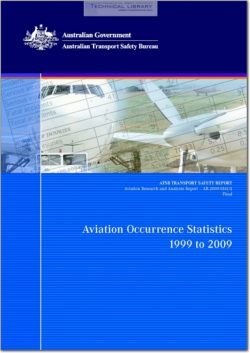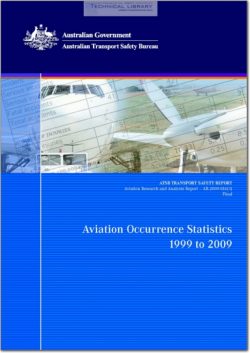ATSB-AR-2009-016(3)

- Version
- 200 Downloads
- 1.33 MB File Size
- 1 File Count
- August 9, 2016 Create Date
- August 9, 2016 Last Updated
Aviation Occurrence Statistics - 1999 to 2009

Each year, ‘responsible persons’, as defined in the Transport Safety Investigation Regulations 2003, Part
25, provide the Australia n Transport Safety Bur eau (ATSB) W ith reports on aviation accidents and
incidents, collectively termed o ccurrences. These reports are used by the ATSB to ass ist with the
independent investigation of occurrences and for identifying safety trends.
This report provides aviation occurrence data for the period 1 January 1999 to 31 December 2009. The
data contained herein is dynamic and subject to change pending the provision of new information to the
ATSB. The data will be adjusted biannually to re flect new infor mation received during t he reporting
period.
For co mmercial air transp ort (high capacity regular public transport (RPT), low capacity RPT and
charter), although the accident rate had climbed in 2007 and 2008, the number of accidents reduced from
29 (2008) to 11 in 2009. This accide nt trend was In ostly driven by changes in the ace ident rate for
charter operations. Similarly, the number of serious incidents for commercial air transport reduced from
45 (2007 and 2008) to 26 in 2009. There were no fat al air transport accidents in 2009. One significant
accident in 2009 involved the tail scrape and runway excursion at takeoff of a foreign—registered Airbus
A340—500 in Melbourne on 20 March. Charter has an accident rate that is about five ti mes that of low
capacity and high capacity RPT. Most fatal a ccidents in comme rcial air transport are in charter
operations, and it has a similar rate of fatal accidents to all general aviation.
For general aviation (aerial work , flying training, and private/bus iness and (VH-registered) sport
aviation), accidents and serious incidents have remained generally consistent since 2007. In 2009, there
were 126 accidents, including 1 8 fa tal accidents, and 95 serious incidents. Co mpared with fly ing
training, aerial work has an accident rate per million hours that is two times higher, and private/business
has an accident rate that is 2.5 times higher. In terms of fatal accidents per million hours, the fatality rate
in aerial work is three times higher than flying training, and private/business is at least six times higher.
| File | Action |
|---|---|
| ATSB-AR-2009-016(3) Aviation Occurrence Statistics - 1999 to 2009.pdf | Download |

Comment On This Post